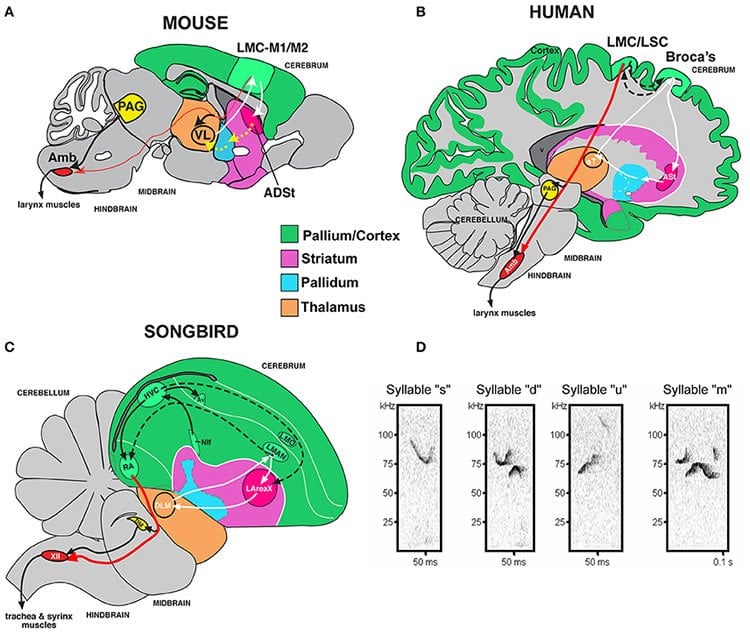Summary: Researchers investigate the effect of a genetic mutation of the FOXP2 gene on the vocalization patterns of adult male mice.
Source: Frontiers.
Study shows vocal communication in mice is affected by the same gene needed for speech in humans.
Our current understanding is that mice have either no — or extremely limited — neural circuitry and genes similar to those that regulate human speech. According to a recent study published in Frontiers in Behavioral Neuroscience, this understanding may be incorrect.
Dr. Jonathan Chabout is the lead author of the paper, whose principal investigator is Dr. Erich Jarvis.
Dr. Jarvis and colleagues report the results of their investigation into the effect of a genetic mutation in the Forkhead box protein #2 (FOXP2) on the vocalization patterns of adult male mice. FOXP2 regulates speech production in humans. Individuals with deficiencies in FOXP2 protein have difficulty forming complex syllables and complex sentence construction.
Although mice are unable to communicate using speech in the same way as humans, they do vocalize as a means of communicating with each other. Therefore this study sought to determine whether FOXP2 deficiencies have similar consequences for communication by mice as they do for humans.
They do.
Dr. Jarvis suggests that this study supports the “continuum hypothesis,” which is that FOXP2 affects the vocal production of all mammals and not just humans.
Dr. Jarvis’ team investigated twenty-six (26) male mice bred to have a FOXP2 mutation the same as that found in humans with speech deficits, and twenty-four (24) “wildtype” male mice (i.e., mice with a normal level of FOXP2 protein).
Both types of male mice (the heterozygous mice containing the FOXP2 mutation and the wildtype mice) were placed in several unique contexts — housed with an active wildtype female mouse, in proximity of only the urine of wildtype females, or housed with a sleeping female or sleeping male mouse. These particular contexts derived from prior research published by Chabout and colleagues in 2015.
This past study found that in these various social contexts, healthy males produced differences in the sequence and duration of the ultrasonic vocalizations (USVs), which are high-pitched sounds inaudible to humans, that mice make. In their new study, the investigators wished to determine if there was an effect of a FOXP2 deficiency on the communication patterns of mice.

The results showed that the FOXP2 heterozygotes have difficulty producing the complex vocal communication patterns that wildtype mice can create with ease — as measured both by syllable length and the number of unique syllables produced over time. These divergences are particularly strong when comparing the communication of FOXP2 heterozygotes and wildtype males while in the presence of active female mice. In this context, the wildtype males were 3 times as likely as heterozygotes to produce the most complex syllable types and sequences available for review. Dr. Jarvis’ team performed intricate statistical analyses to validate this finding, and their conclusion held true.
Following the conclusion of all recordings, Dr. Jarvis’ team used a process known as transsynaptic tracing from vocal larynx muscles to compare the vocal brain regions of wildtype and heterozygote FOXP2 mice. This study revealed that the heterozygote’s vocal motor neurons were more widely distributed across the cortex than was the case for wildtype mice. This evidence suggests that the FOXP2 mutation affects both the placement and functioning of the neurons connected to effective communication, from mice all the way to humans.
Prior research has shown a more limited role for FOXP2 than what is now becoming apparent. As Dr. Jarvis observes, “We believe that FOXP2 already had a pre-existing role in regulating vocal communication before human language evolved.”
Funding: Funding provided by Howard Hughes Medical Institute, Max Planck Society, Office of Naval Research.
Source: Monica Favre – Frontiers
Image Source: NeuroscienceNews.com image is credited to the researchers/Frontiers in Behavioral Neuroscience.
Original Research: Full open access research for “A Foxp2 Mutation Implicated in Human Speech Deficits Alters Sequencing of Ultrasonic Vocalizations in Adult Male Mice” by Jonathan Chabout, Abhra Sarkar, Sheel R. Patel, Taylor Radden, David B. Dunson, Simon E. Fisher and Erich D. Jarvis in Frontiers in Behavioral Neuroscience. Published online October 20 2016 doi:10.3389/fnbeh.2016.00197
[cbtabs][cbtab title=”MLA”]Frontiers. “Genes for Speech May Not Be Limited to Humans.” NeuroscienceNews. NeuroscienceNews, 15 November 2016.
<https://neurosciencenews.com/genetics-speech-animals-5524/>.[/cbtab][cbtab title=”APA”]Frontiers. (2016, November 15). Genes for Speech May Not Be Limited to Humans. NeuroscienceNews. Retrieved November 15, 2016 from https://neurosciencenews.com/genetics-speech-animals-5524/[/cbtab][cbtab title=”Chicago”]Frontiers. “Genes for Speech May Not Be Limited to Humans.” https://neurosciencenews.com/genetics-speech-animals-5524/ (accessed November 15, 2016).[/cbtab][/cbtabs]
Abstract
A Foxp2 Mutation Implicated in Human Speech Deficits Alters Sequencing of Ultrasonic Vocalizations in Adult Male Mice
Development of proficient spoken language skills is disrupted by mutations of the FOXP2 transcription factor. A heterozygous missense mutation in the KE family causes speech apraxia, involving difficulty producing words with complex learned sequences of syllables. Manipulations in songbirds have helped to elucidate the role of this gene in vocal learning, but findings in non-human mammals have been limited or inconclusive. Here, we performed a systematic study of ultrasonic vocalizations (USVs) of adult male mice carrying the KE family mutation. Using novel statistical tools, we found that Foxp2 heterozygous mice did not have detectable changes in USV syllable acoustic structure, but produced shorter sequences and did not shift to more complex syntax in social contexts where wildtype animals did. Heterozygous mice also displayed a shift in the position of their rudimentary laryngeal motor cortex (LMC) layer-5 neurons. Our findings indicate that although mouse USVs are mostly innate, the underlying contributions of FoxP2 to sequencing of vocalizations are conserved with humans.
“A Foxp2 Mutation Implicated in Human Speech Deficits Alters Sequencing of Ultrasonic Vocalizations in Adult Male Mice” by Jonathan Chabout, Abhra Sarkar, Sheel R. Patel, Taylor Radden, David B. Dunson, Simon E. Fisher and Erich D. Jarvis in Frontiers in Behavioral Neuroscience. Published online October 20 2016 doi:10.3389/fnbeh.2016.00197






